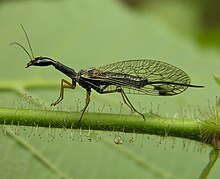| Snakefly Temporal range:
| |
|---|---|

| |
| Female Dichrostigma flavipes | |
| Scientific classification | |
| Domain: | Eukaryota |
| Kingdom: | Animalia |
| Phylum: | Arthropoda |
| Class: | Insecta |
| Clade: | Neuropterida |
| Order: | Raphidioptera Handlirsch, 1908 |
| Suborders | |
| Synonyms | |
| |
Snakeflies are a group of predatory insects comprising the order Raphidioptera with two extant families: Raphidiidae and Inocelliidae, consisting of roughly 260 species. In the past, the group had a much wider distribution than it does now; snakeflies are found in temperate regions worldwide but are absent from the tropics and the Southern Hemisphere. Recognisable representatives of the group first appeared during the Early Jurassic. They are a relict group, having reached their apex of diversity during the Cretaceous before undergoing substantial decline.
An adult snakefly resembles a lacewing in appearance but has a notably elongated thorax which, together with the mobile head, gives the group their common name. The body is long and slender and the two pairs of long, membranous wings are prominently veined. Females have a large and sturdy ovipositor which is used to deposit eggs in some concealed location. They are holometabolous insects with a four-stage life cycle consisting of eggs, larvae, pupae and adults. In most species, the larvae develop under the bark of trees. They may take several years before they undergo metamorphosis, requiring a period of chilling before pupation takes place. Both adults and larvae are predators of soft-bodied arthropods.